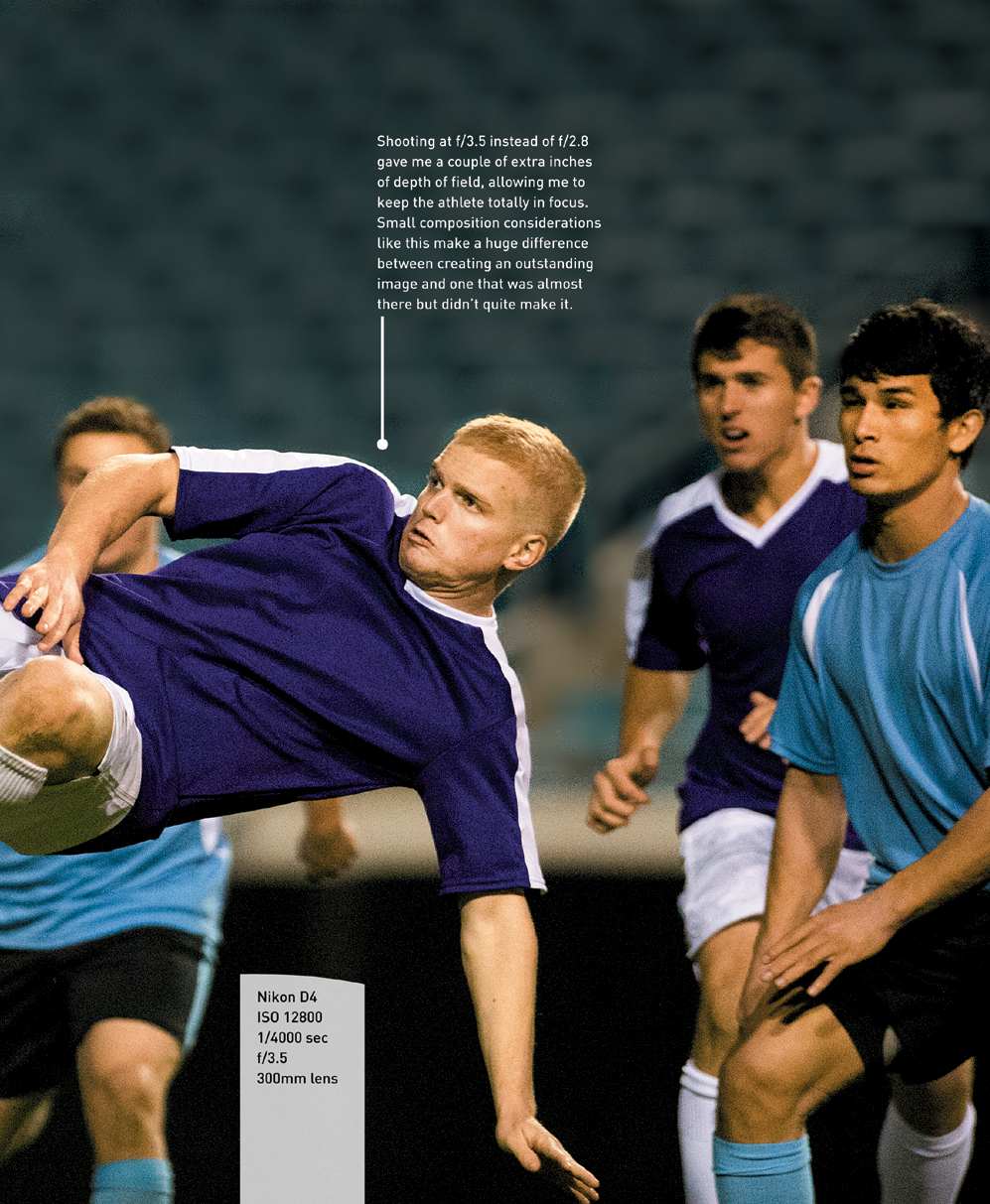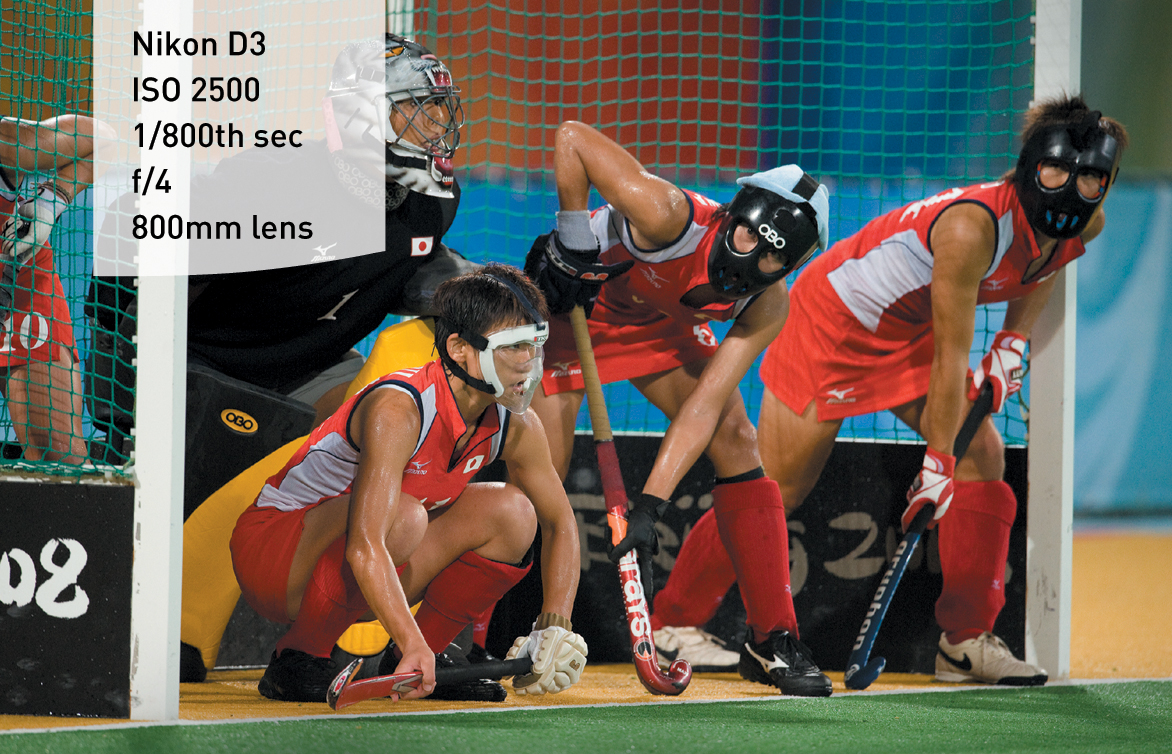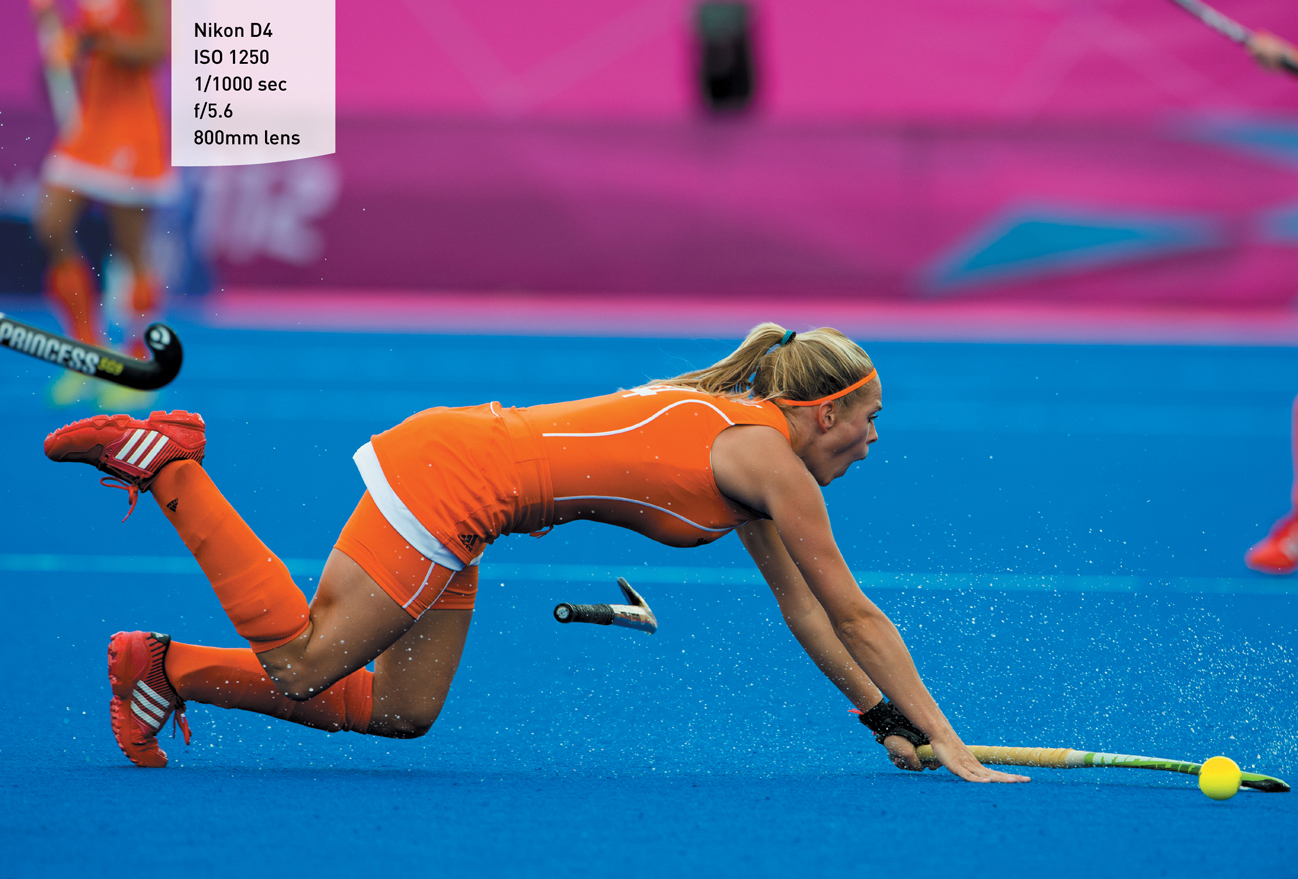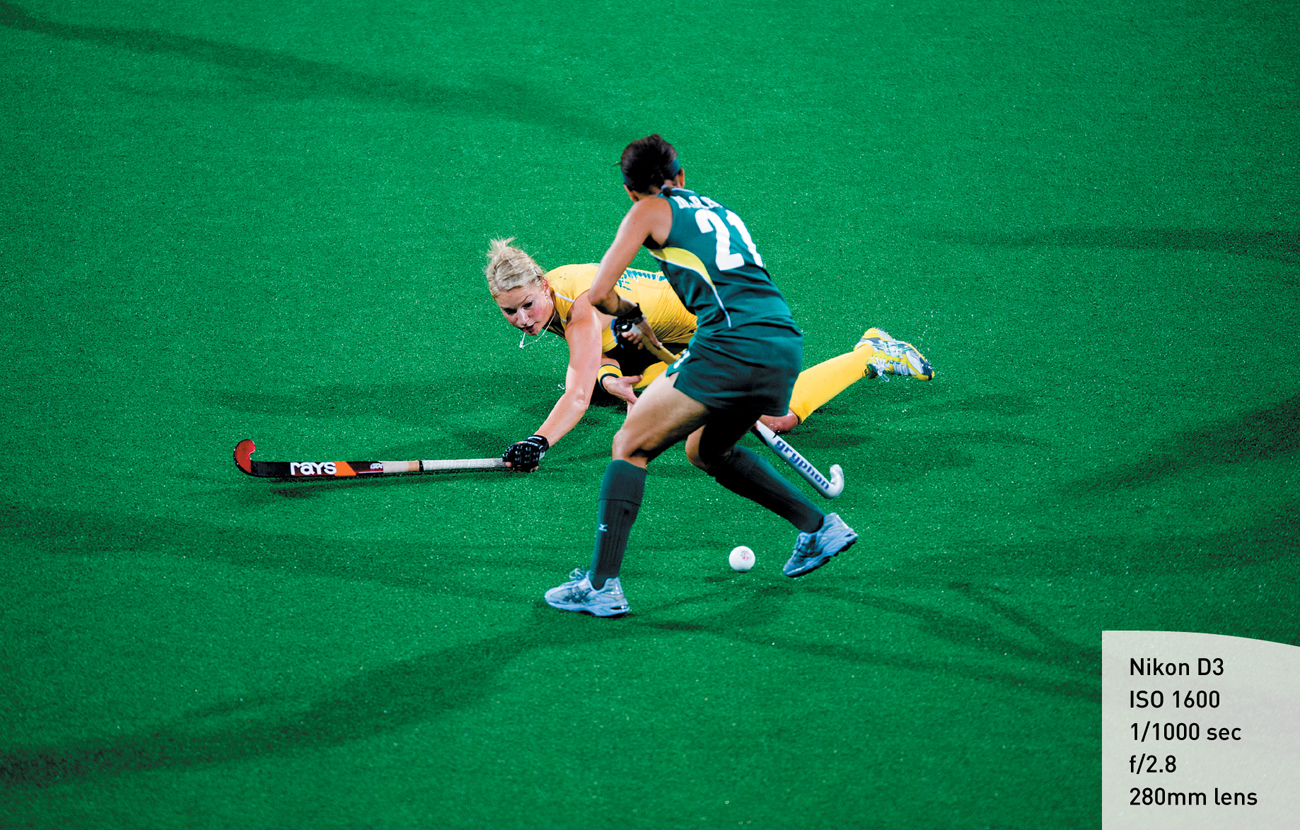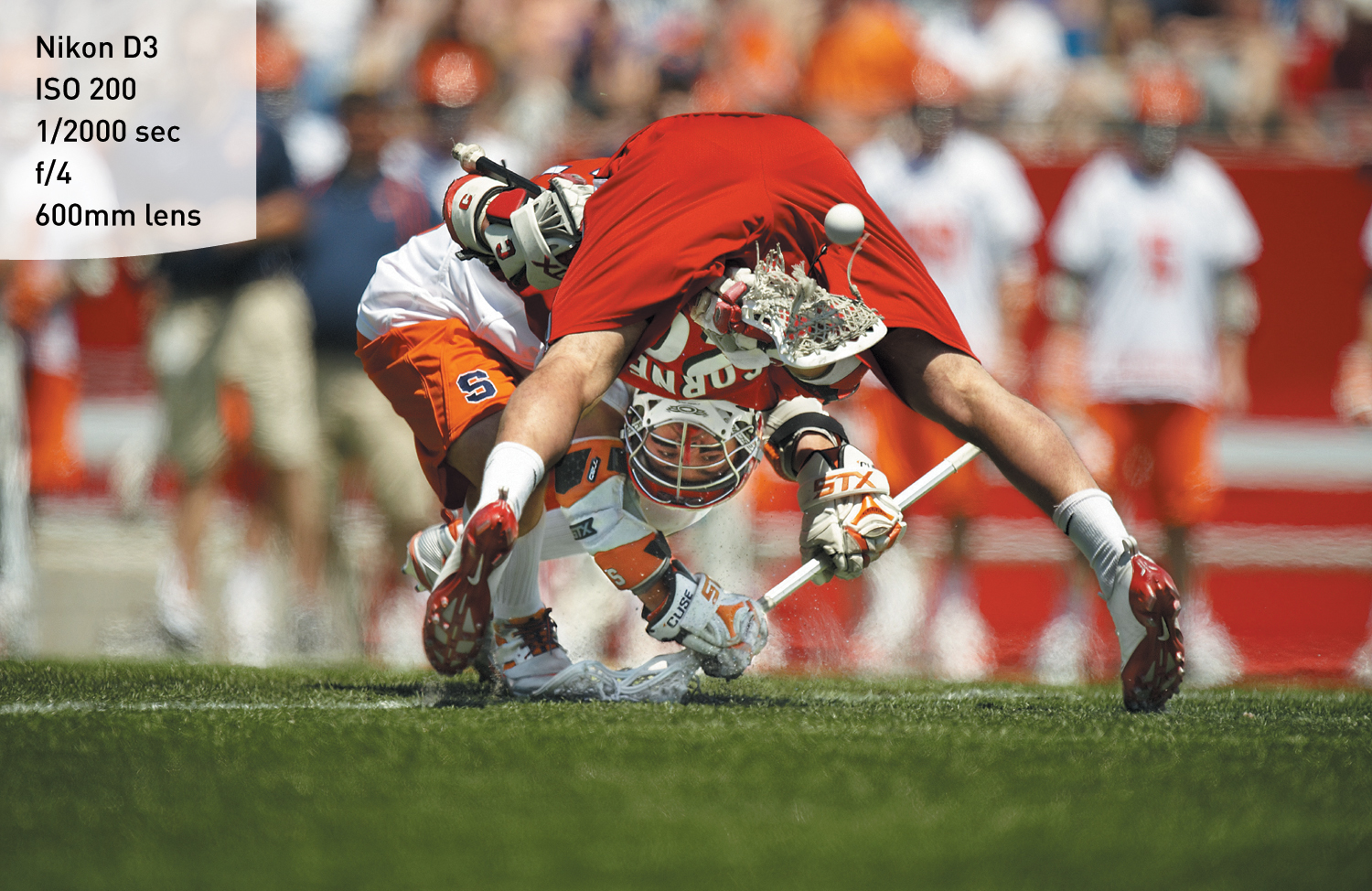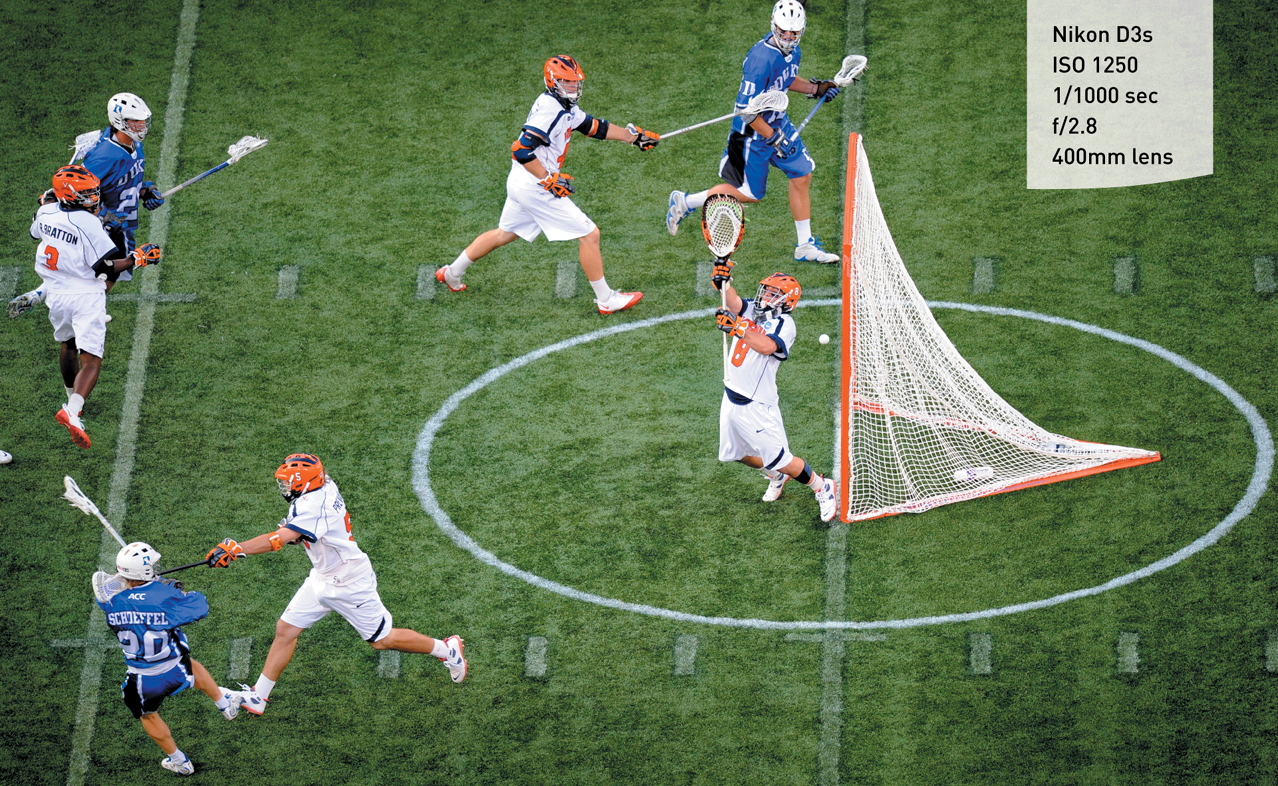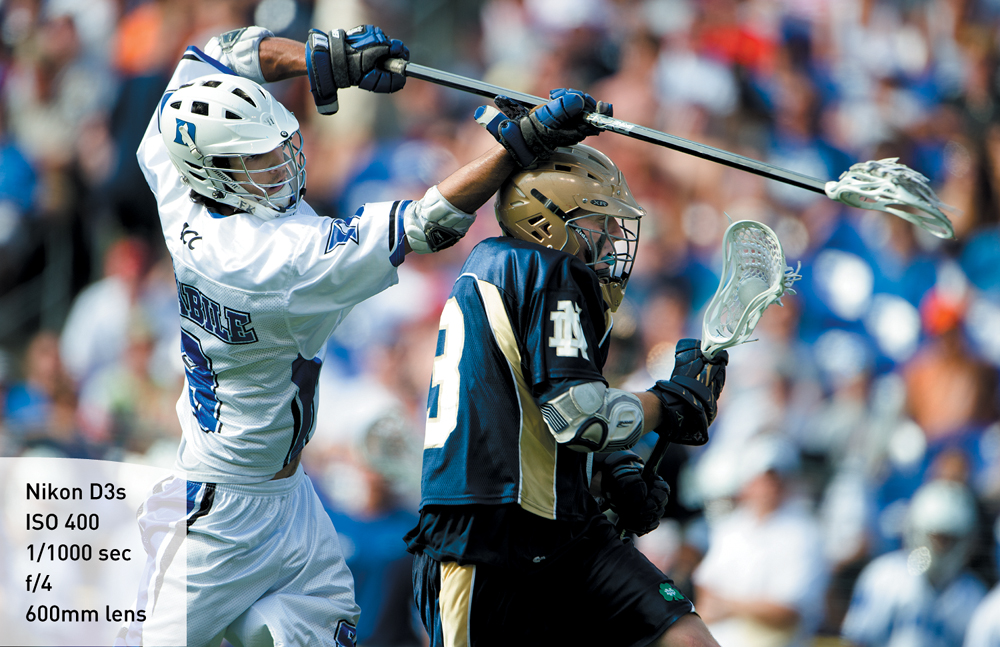10. Quick Action
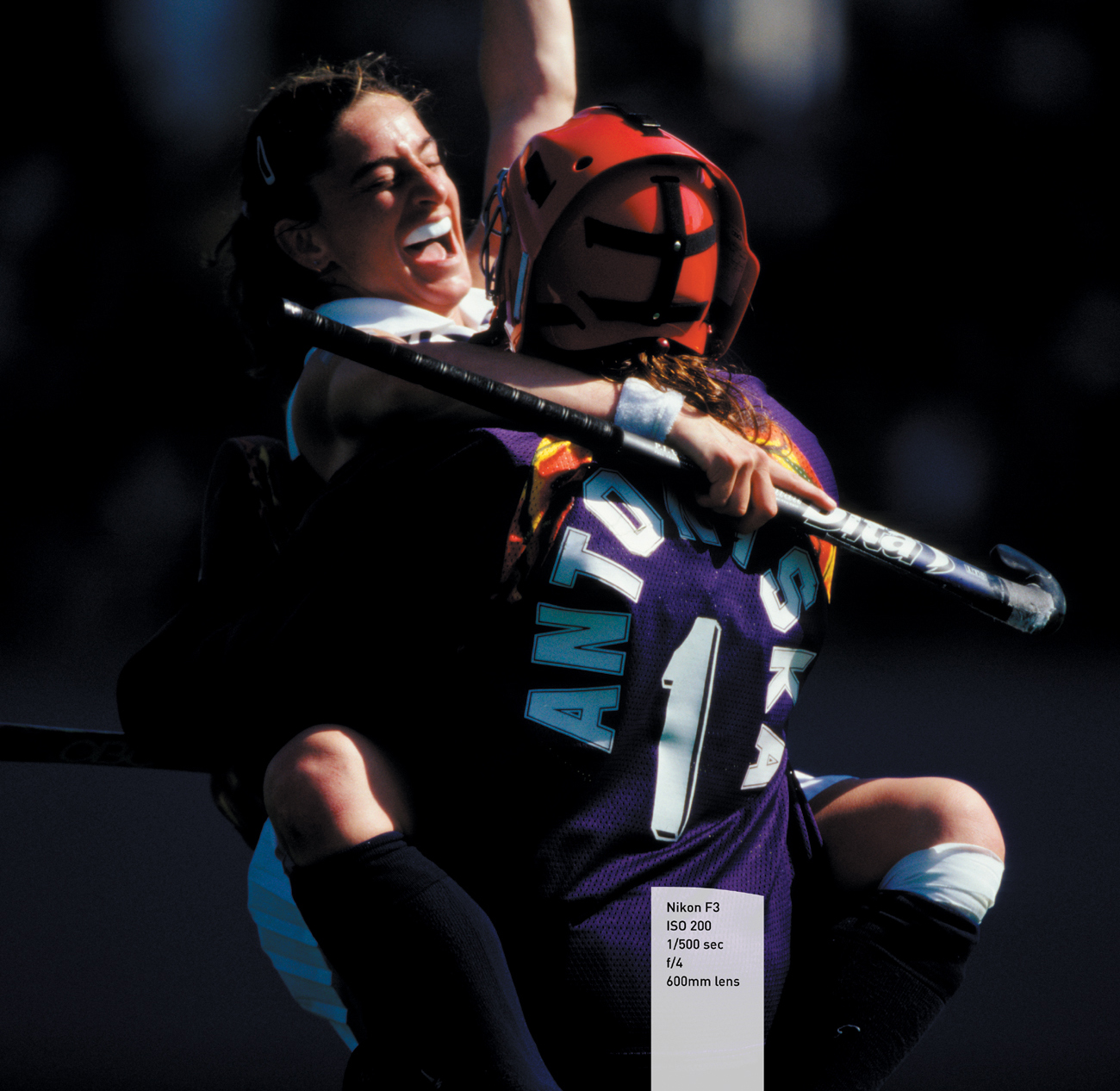
Women celebrate winning a field hockey game. Using the late afternoon light, I was able to expose for only the face of the athlete and draw it out of the dark background.
Soccer, Lacrosse, and Field Hockey
Soccer, lacrosse, and field hockey are all very fast-paced games played on large fields. This changes how you cover these sports. For example, in basketball you are limited by space. In football, the action is broken up, giving you time to decide where to go next. But in the three sports discussed in this chapter your space is not restricted and you have very little time to react to the pace.
This chapter looks at each sport—soccer, lacrosse, and field hockey—separately to show you what works best. I’ll discuss the best shooting positions for each, and then describe the gear and settings I recommend for photographing these sports.
Poring Over the Picture
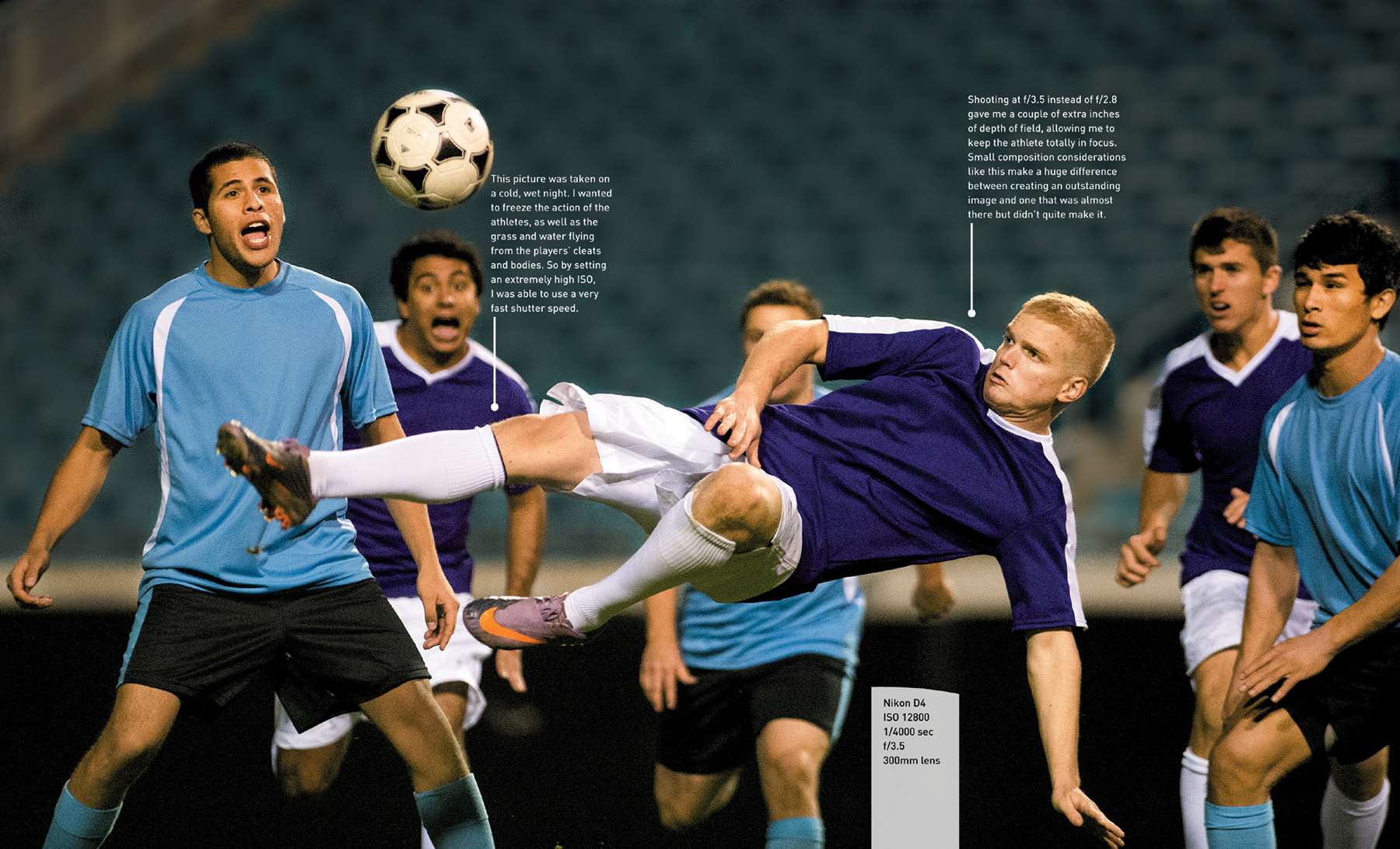
Anticipation is the key to all sports photography. Big kicks, like this bicycle kick, happen quickly, and if you aren’t ready, you’ll miss it.
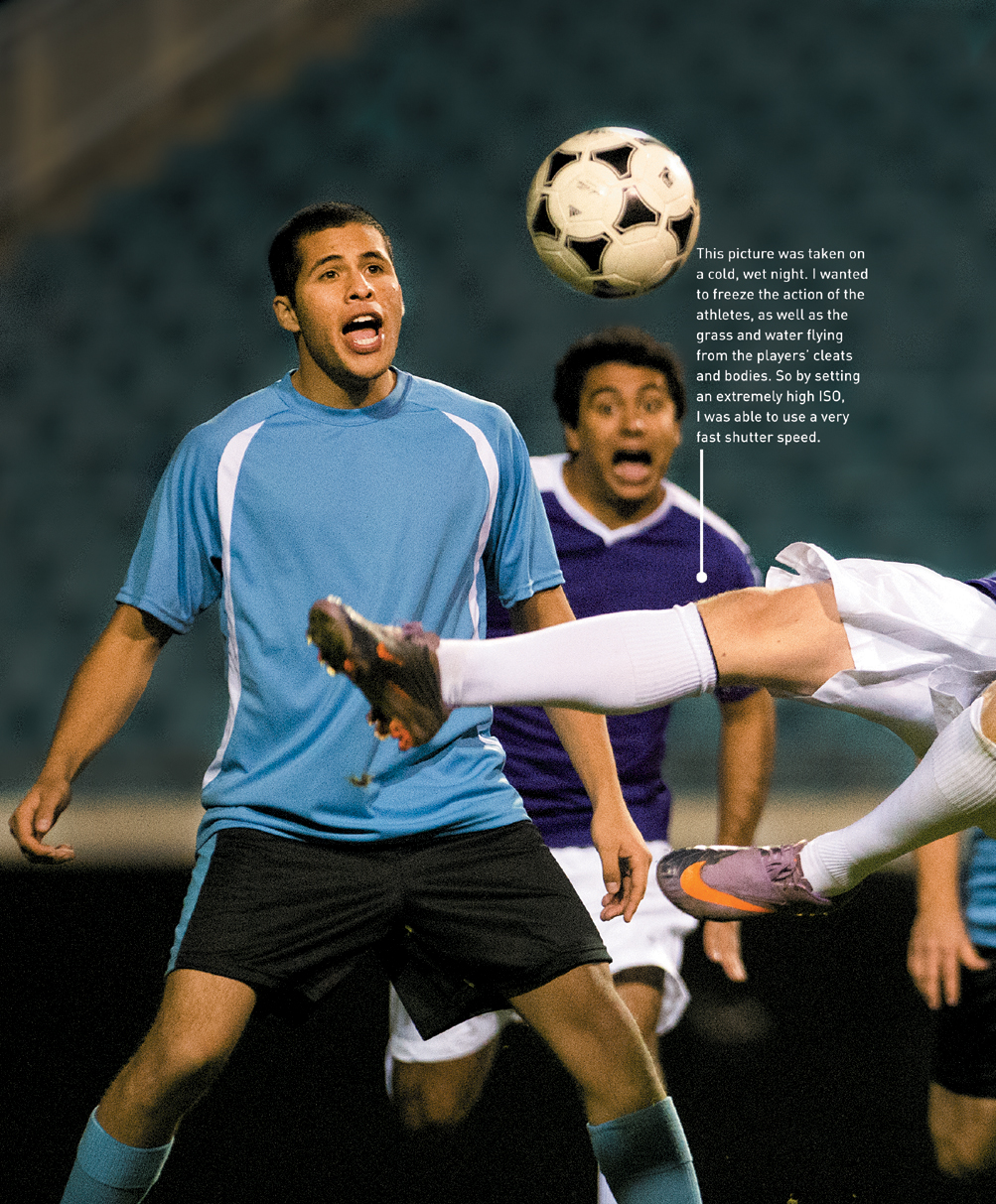
Soccer: How to Get the Best Shots
Soccer is the most popular international sport. From the World Cup to little league, the game moves fast, and finding the best shots needs to be a quick process. Getting great shots of the athletes is easier than in some other sports because they are uninhibited by padding, allowing you to capture a lot of emotion in their faces.
Where to Position Yourself
Because soccer players and the game move so quickly, you cannot follow the action from one end of the field to the other with any precision. Therefore, I focus on two areas during soccer games: the sidelines by the corner arc and behind the goal line. Note that you are not allowed to stand behind the actual goal in NCAA and professional soccer for safety reasons. In addition to describing how to shoot from these two areas, I’ll explain how to use one simple, wide-angle remote camera in the goal.
Corner Arc
The sidelines by the corner arc are great spots to get action shots around the goal. Going into a game I’m usually asked to follow a team or player and unless I am focusing on a defensive player, I’ll always shoot that team and/or player on offense. Shooting from the sidelines gives you a clean side look (Figure 10.1). They are also great places to capture slides and hits.
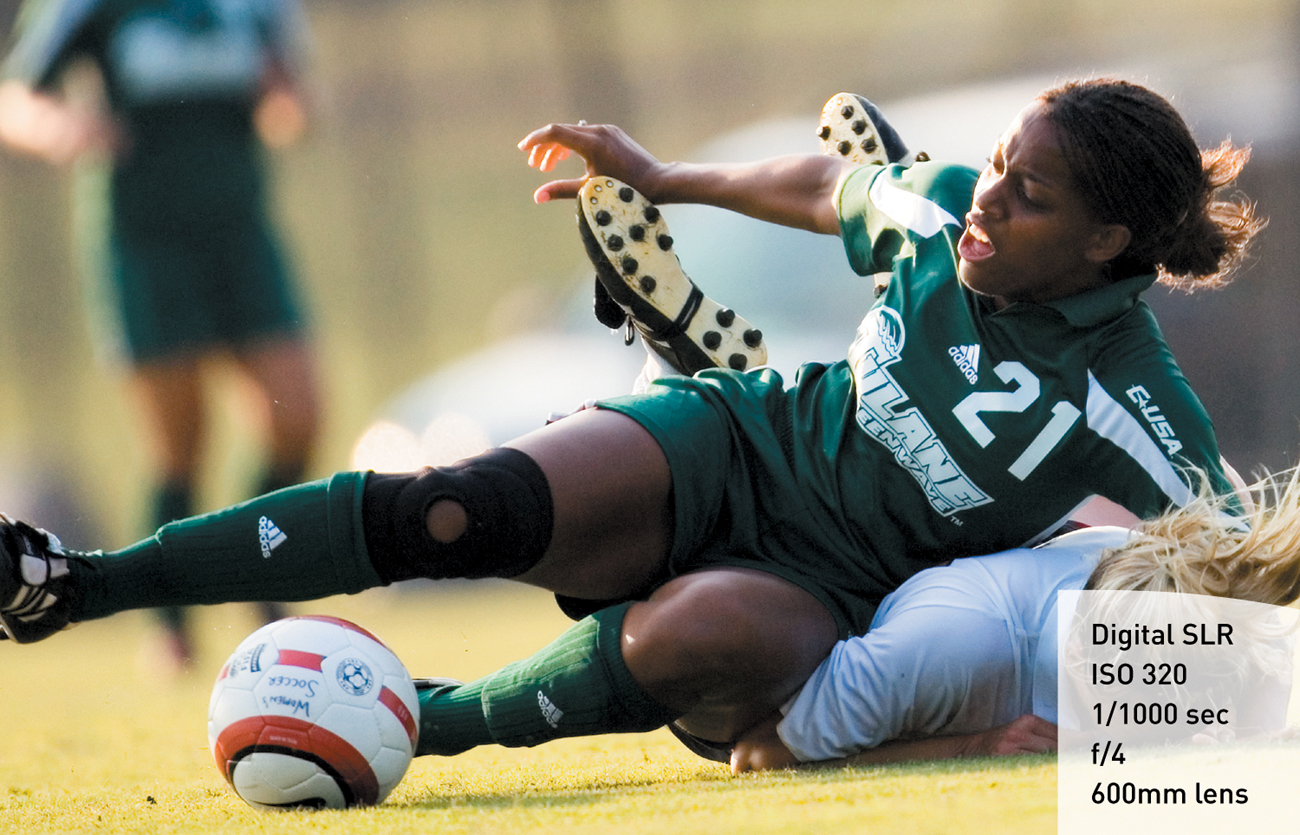
Figure 10.1 A player from Tulane University’s women’s soccer team fights an opposing player for the ball. Shooting low from the sidelines with a long lens allowed me to make a tight, clean shot of the action.
Goal Line
Shooting behind the goal line is also ideal to get action around the goal. This position gives you a more head-on look at the action than the corner arc. I always shoot from as close to the goal as possible for penalty kicks and kicks from the corner arc (Figure 10.2).
Tip
Penalty kicks make for interesting photographs almost every time. You can concentrate on the players preparing to block the kick. It’s a simple and often evocative shot to make.
Field Hockey: How to Get the Best Shots
Field hockey, like soccer, is a great sport to cover because the athletes do not wear anything to obstruct their faces, like helmets or hats. Field hockey is fast, low to the ground, and a fun sport to shoot.
Where to Position Yourself
When I cover field hockey, I generally work from three locations: the sidelines, behind the goal line, and in an elevated position. For safety reasons, you are not allowed to stand behind the goals.
Sidelines
The sidelines in field hockey give you a great look at the action. Because field hockey is played low to the ground, the athletes usually spend a lot of time on the ground, either diving for the ball or getting knocked down by other players.
By getting low on the sidelines with a long lens, I was able to capture a high-action moment in Figure 10.3. I wanted to make sure the athlete and the sticks were in focus, so I shot with a slightly greater depth of field.
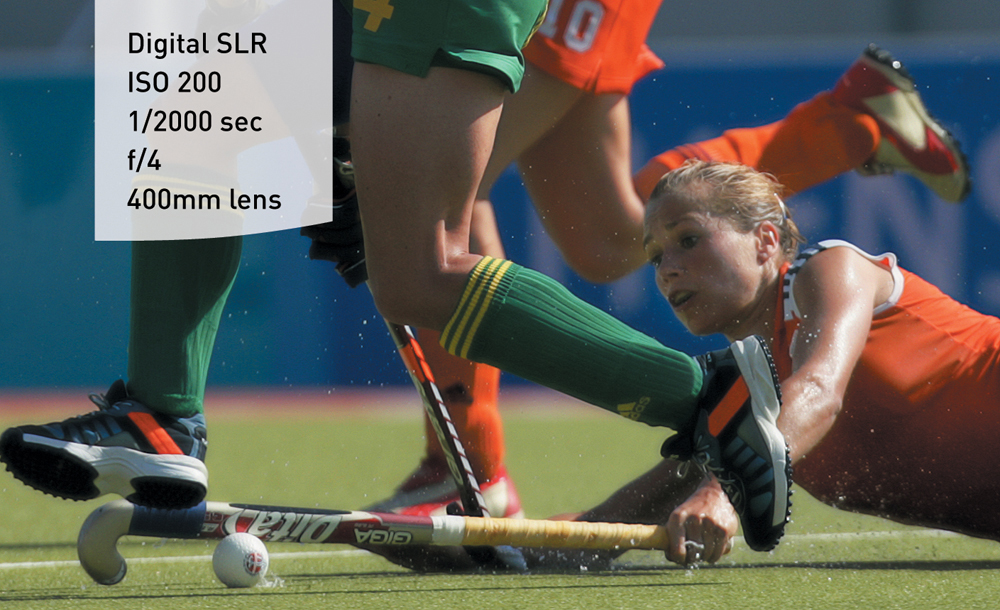
Figure 10.3 This photo was taken during a game between the Netherlands and Australia during the 2004 Olympics.
The sidelines are also good places to shoot penalty shots. Penalty shots in field hockey are visually appealing because of the face masks the players wear (Figure 10.4).
If a goal is scored, the players will run to the player who scored the goal. It happens every time and is the best chance to make a celebration image.
Goal Line
I also spend a lot of time behind the goal line during field hockey games. It’s a good place to shoot the action around the goal and coming down the field. I made the image in Figure 10.5 with the longest lens I could find and sat behind the goal line to capture the action.
Elevated Position
Shooting from elevated positions is a great way to get a more encompassing look at the action. Because field hockey is played outside, an elevated position allows you to take advantage of light and shadows in a way that isn’t possible from ground level.
The game in Figure 10.6 was played at night, so shooting from an elevated position allowed me to use higher shutter speeds because there was more light. It also allowed me to take advantage of the shadows created by the artificial lights.
Figure 3.5 in Chapter 3 shows one of my favorite images from this position.
Lacrosse: How to Get the Best Shots
Lacrosse has gained huge popularity in the United States over the last several years. The NCAA men’s lacrosse tournament is a terrific event to cover, because the game is fast-paced and fun to watch.
Where to Position Yourself
While shooting lacrosse games, I work from three main areas: the sidelines at the center line, the sidelines at the attack/defense areas, and in an elevated position.
Center Line
The center line is the best place to be for the face-off, which always creates great images. Lacrosse moves very quickly, but the face-off is the one time in every game when you are guaranteed to have two players in the same place at the same time. It is one shot you can prepare for.
Lining up on the sidelines by the center line for the face-off shown in Figure 10.7 allowed me to capture the moment the game started. The image is different from a sports perspective because of the position of the players.
Tip
Shooting the face-off shot with a long lens from a low angle makes a very interesting and often funny picture.
Attack/Defense Area Sidelines
The attack/defense area sidelines are my favored positions to cover lacrosse. The goal is not located on the base line, like soccer or field hockey, so being on the sidelines actually is the best place to capture the action around the goal (Figure 10.8 and Figure 10.9).
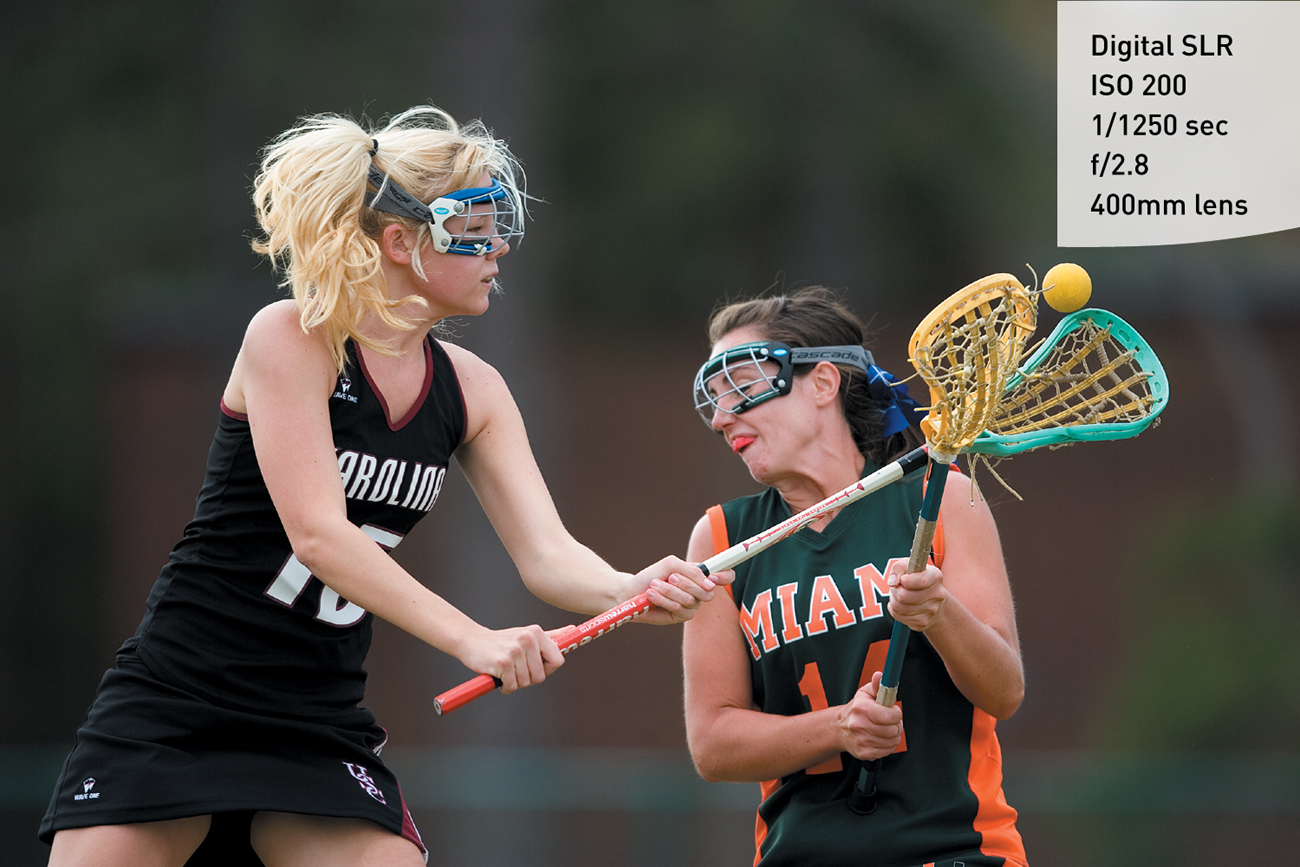
Figure 10.8 Miami plays South Carolina during a game in 2006. Shooting from the sidelines gave me a clean view of the athletes’ faces at they attacked each other.

Figure 10.9 The Notre Dame goalie braces for a shot from Cornell during the 2010 NCAA Championship. Shooting from the sidelines gives you a clean view of the goal and the action around it.
Elevated Position
Again, an elevated position gives you a different look at the action on the field. Lacrosse fields have lots of lines and shapes, so elevated positions allow you to take advantage of color and shapes, and make action photos with a unique look (Figure 10.10).
My Gear
The nature of soccer, lacrosse, and field hockey lends them to being photographed using extremely long glass. I love to shoot these sports with the Nikkor 800mm f/5.6, but that lens is rare and very expensive. Here is my gear list that I would absolutely bring to a soccer, field hockey, or lacrosse game:
• Three Nikon D4 bodies
• One Nikon D800
• 800mm f/5.6 lens
• 600mm f/4 lens
• 400mm f/2.8 lens
• 70–200mm f/2.8 lens
• 14–24mm f/2.8 lens
• TC 1.4x teleconverter
• Two Gitzo monopods
If you have only one camera, bring the longest lens you have or can get. Teleconverters are great for these sports also. I recommend the TC 1.4x because it will normally be the sharpest teleconverter, but if you have a good TC 2x, the extra length could be very helpful. It is important to have as much reach as possible, because so much of the game will be played far from where your position will be.
The Camera Settings
Because soccer, field hockey, and lacrosse are outdoor sports, it is more difficult to calculate exposure. Images taken at a noon game will look very different from those taken at a game played at 9:00 at night.
Always consider how much of the frame you want to be in focus. People tend to put their cameras on the widest aperture possible for photographing sports, but that isn’t always the best way to go. However, sometimes you must allow as much light into the sensor as possible, like at night. Once you decide your depth of field, set your shutter speed at a high enough speed to stop action, and then set your ISO to fit your other two calculations.
I like to freeze action, so I always shoot using a shutter speed of at least 1/1000 of a second.
Covering the Moments Before the Game
Be aware of extenuating circumstances when you cover any sport. There is always a compelling story outside of the game, whether it is a personal feat that a coach or player has overcome or achieved, or a traumatic experience the team has come through.
I covered a Nebraska women’s soccer game after one of the team’s star players was killed randomly at a party the weekend before. She had been at the wrong place at the wrong time and was killed by a stray bullet. Before the game the team players lined up for the national anthem as they always did, leaving a space where she stood and filling it only with the joined hands of two teammates (Figure 10.11).
Covering the Action
As mentioned earlier, shooting soccer, field hockey, and lacrosse is all about anticipation. The more you know about the sport you are shooting, the easier you can anticipate what will happen next. The first time I shot lacrosse—even after doing research on the rules of the game beforehand—I was lost. It took half of a game to begin to understand the action happening in front of me. It made shooting that first game very difficult, but it was also fun to learn.
In these fast-paced games, it is important to know where the ball is at all times (Figure 10.12). Following the ball is hard work because the players are so fast, but it allows you more chances to make great images and also keeps you safe.
Covering the Moments After the Game
As discussed in previous chapters, reaction photos can be as important as action photos. Always keep an eye out for celebration after a big game (Figure 10.13 and Figure 10.14).
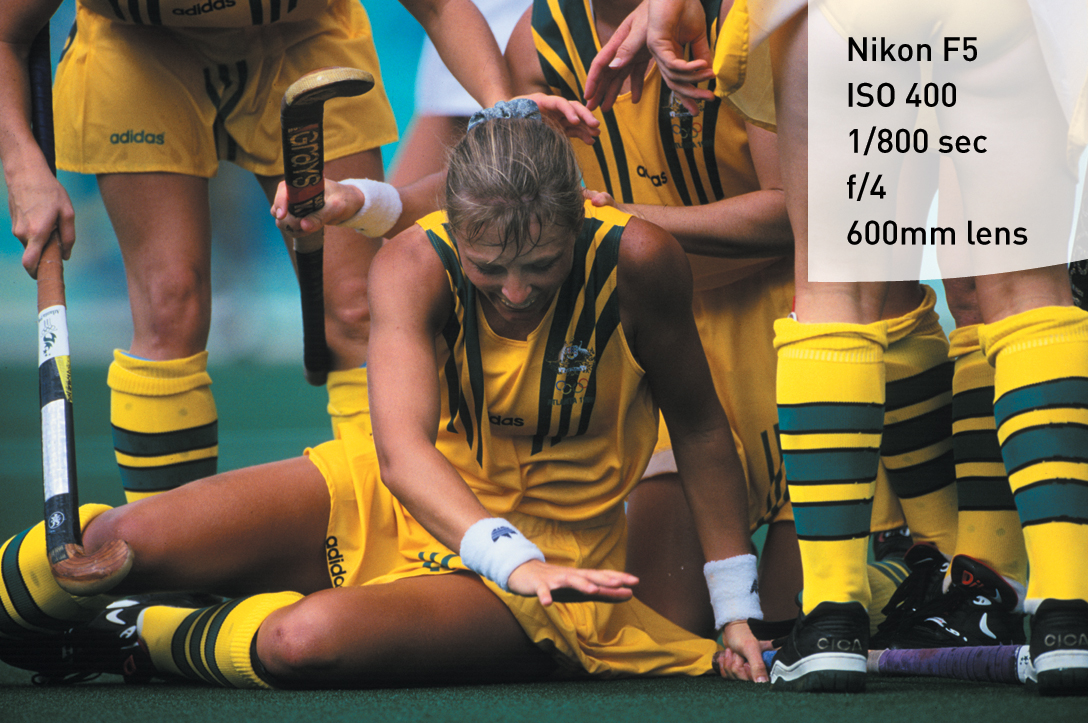
Figure 10.13 The Australian field hockey team celebrates after winning a game during the 2004 Olympic Games.
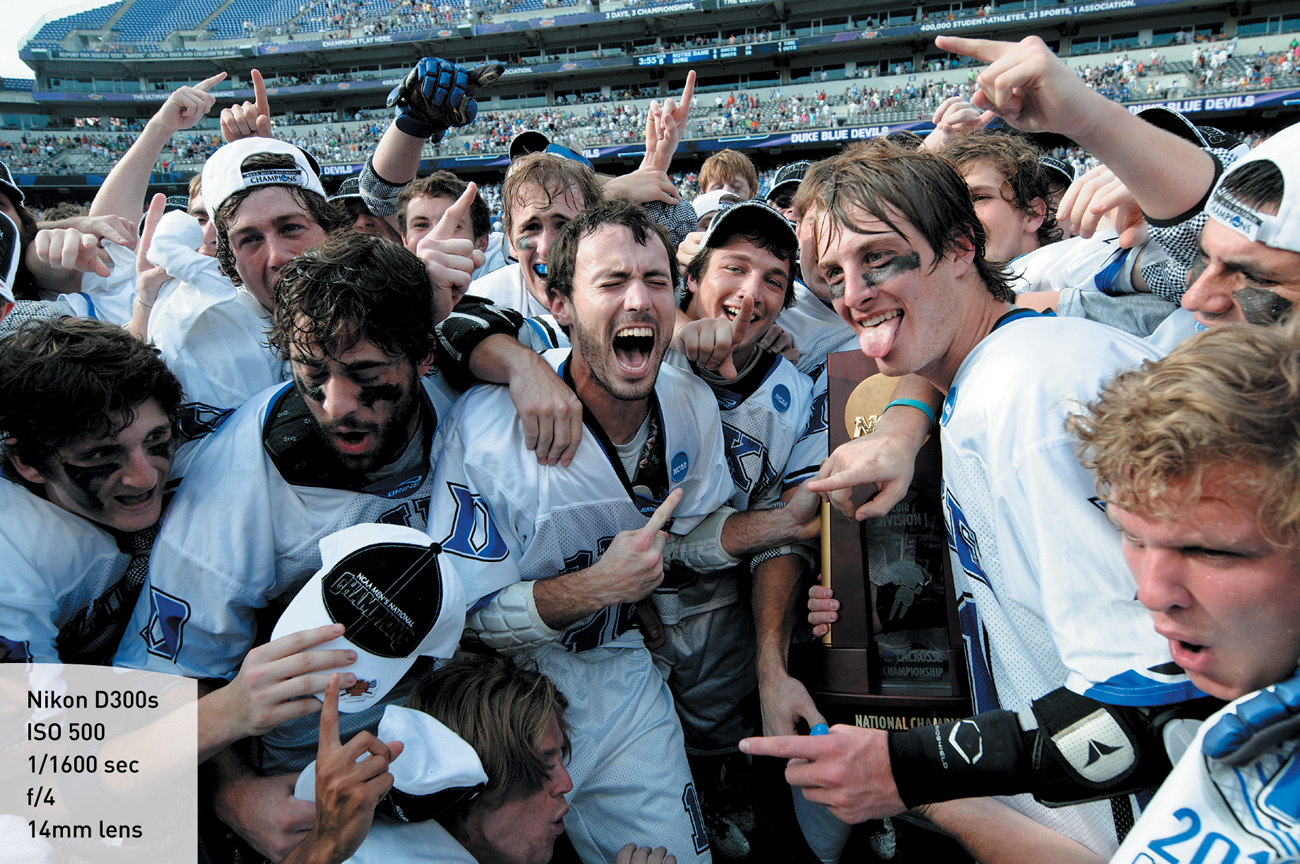
Figure 10.14 The Duke men’s lacrosse team celebrates after winning the 2010 NCAA Lacrosse Championship.
Chapter 10 Assignments
All of the sports discussed in this chapter have very similar motions and concepts. The assignments are thus fairly interchangeable. The lessons learned from one sport transfer easily to another.
Creating Portraits
Go to a little league soccer game before it starts. Spend time shooting the athletes getting ready for the game. Practice making feature pictures and portraits before the game begins. Work on making interesting images showing the relationships between the players and coaches.
Anticipating the Action
Go to a lacrosse game. Try to find a high angle to shoot from and watch the patterns of colors and shapes develop to make unique images. Learn to anticipate when the ball will change teams and the movement will switch quickly from one end of the field to the other.
Timing the Ball
Go to a field hockey game and position yourself side on to the goal. Before the game begins, the athletes will spend significant time taking shots on goal. Learn to time the ball leaving the stick and then the goalie stopping the ball from entering the goal. During an actual game this will not happen often, but during warm-ups you will have many chances to practice taking these images.
Share your results with the book’s Flickr group!
Join the group here: flickr.com/groups/sportsphotographyfromsnapshotstogreatshots.

